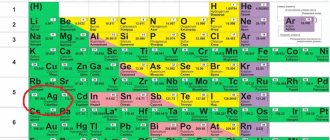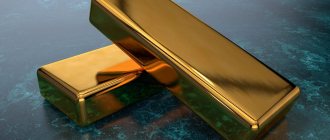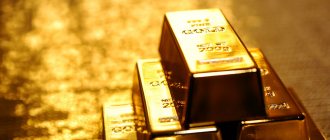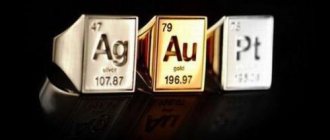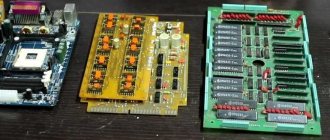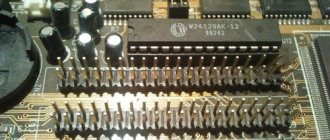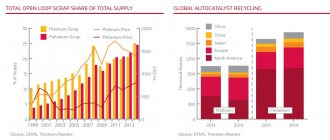Palladium in its pure form is rarely found in nature. It is usually mined from nickel and other ores. To obtain pure material, palladium is refined using hydrochloric acid and oxygen. Industrial technologies for extracting material require the use of hazardous chemicals, so such methods cannot be used at home.
What radio components contain
Precious metals were used in the production of Soviet devices, since at that time the market was focused on high quality.
Noble metals are resistant to adverse environmental conditions, do not wear out and do not oxidize. In what kind of radio components gold, palladium and platinum can be found, you can guess by their importance in devices
Approximate percentage of palladium in radio components.
| Item name | Palladium percentage (%) |
| Spirals and windings of flux chords for markings KSP, KSU, KSD and potentiometers PTP-2 | 80 |
| KSP relay contacts, RES relays 7 and 8 | 78 |
| Capacitors PPML IM | 60 |
| Contacts from resistors SP5-14 22 Ohm and SP5-14 33 Ohm | 58 |
| Pins of the contact group of resistors SP5-17-10 Ohm, SP3-37 | 28 |
| Roller winding and contact group of resistors, PP3 from 40 to 47 | 20 |
| Contact areas, SP5 circles | 18 |
Which radio components contain the most Pd?
- Radio technical scrap of military electronic equipment.
- Palladium capacitors (usually green) marked KM.
- Metal core resistors.
- Oscilloscope wire types C114 - 125, C1-9-9.
- Switch contacts.
Most semiconductor devices contain platinum group metals, but in quantities that are insignificant for refining.
Where else can you find it?
Palladium can be extracted from computer parts. The same principle applies here - the older the unit, the greater the chance of getting a good metal yield.
Modern microcircuits contain a Pt-Pd alloy, but the yield of palladium from these parts will be insignificant. But it’s worth looking for pioneer chips.
Today, palladium is used as a catalyst in air purification systems from exhaust gases, and in the USSR it was used in gas mask filters of the DP-2 type
What precious metals can be refined?
Through the fundamental principles of refining, appropriate equipment and reagents, it is possible to obtain secondary precious metals (SPM) of high purity.
The register of noble metals, which can be obtained by purification from foreign impurities - other alloys, polymers, etc., is as follows :
- gold;
- silver;
- platinum;
- palladium;
- tantalum;
- osmium;
- iridium.
Due to the relatively simple technology of purification and the availability of raw materials, the first two precious metals are the most popular among the people.
Platinum and palladium are refined less frequently due to the complexity of the purification process and subsequent sale .
All of the listed metals, with the exception of technical silver, are expensive elements. If you have information on how to carry out refining at home, which radio components or other raw materials contain the largest amount of rare earth elements, recycling can generate good income.
We talked about the content of precious metals in radio components here. You will also find this article useful on how to refinish radio components at home. Those wishing to remove silver from contacts will find this material useful.
Gold refining methods
Buying gold in Penza
Methods for purifying precious metals are divided into:
- chemical (based on the interaction of substances, there are dry and wet);
- electrochemical (electrolysis).
Dry
When talking about the dry method of gold purification, they mean the Miller method. It is used only in industrial conditions due to the toxicity and corrosiveness of chlorine and its compounds, which are released in excess during the reaction.
The essence of the method: chlorine gas is passed through the crushed mass of the processed substance. Compounds of base metals with chlorine are volatile and are removed from the alloy, increasing the gold purity.
Miller's method is effective due to the fact that noble metals react with chlorine last (zinc and iron are removed first, gold and platinum are removed last). Its advantages:
- it is inexpensive;
- does not require large areas to accommodate equipment;
- short - takes several hours;
- removes almost all alloy, increasing the gold content in the alloy to 99.5–99.9%.
The refining process takes place in a crucible (a refractory melting tank), into which chlorine enters through a pipe. Excess components are removed from the mixture, and silver chloride rises to the surface of the alloy - this makes it possible to further separate the noble metals from each other. Miller's method helps to obtain gold from both a multicomponent alloy and an alloy with silver.
Wet
It is convenient to separate the noble metal from the alloy by dissolving either the metal itself or impurities.
The most popular refining method involves reacting scrap with aqua regia (a mixture of nitric and hydrochloric acids - one of the few compounds that dissolves gold). The solution is evaporated and the gold is precipitated using iron sulfate (also suitable for reduction from chloride), oxalic acid, sodium pyrosulfite or hydrazine.
If the reduction reaction is carried out correctly, the loss of pure substance at the output will be minimal, and the sample will reach 999.
There is a way to dissolve gold using Lugol's solution - a combination of potassium and iodine.
Quarting is also used (from the Latin quarta - fourth) - alloying gold in a ratio of 1:3 with another metal (brass, zinc, copper), which is subsequently dissolved in nitric acid. Impurities will not dissolve qualitatively if their content is less than ¾ of the volume, so the semi-finished product is quartted. Theoretically, you can try this at home, but be aware that when dissolved, it releases very poisonous nitric oxide.
If you have gold in solution, it can be easily refined with stannous chloride powder. A day after the start of the process, the gold will settle to the bottom of the container in which you left it. The good thing about the method with tin chloride is that when using it, the operator’s body is not endangered, as when working with volatile chlorides or acid.
Electrolytic
Electrolysis involves the separation of the constituent components of the alloy on the electrodes as a result of the passage of electric current through the electrolyte. During refining, the anode (electrode with a positive potential) is a gold-containing alloy, and the cathode (electrode with a negative potential) is thin rolled gold (999) tin. An electrolyte is a solution of gold chloride and an acid that dissolves the anode.
The initial anode sample is a minimum of 900. The process takes place in small porcelain baths (~ 25 l) installed on water baths to maintain a temperature of 50–60 ° C. Gold particles settle in layers on the cathode. After the process is completed, the anode sludge is sent for further processing: the silver is separated and melted into anodes for silver electrolysis.
What methods of affining can be carried out at home?
Of course, you cannot conduct an experiment with chlorine at home. But you can try to extract gold from scrap or computer waste using tin chloride and acids. Skilled alchemists can use the electrolytic method. But don't forget about safety precautions!
Palladium jewelry: current samples and forms of existence of the metal
There is a category of jewelry scrap where palladium is accepted, like gold, by weight of each gram. Precious metal waste has its own criteria, which are determined by the breakdown on the product (the most common are 500 and 850) and additionally using measuring equipment. For the highest sample they give the maximum price; it increases if the lot being delivered has large volumes.
Palladium wedding rings
The flexibility of palladium alloys has already been mentioned, but if you touch the pure substance it is too flexible to represent independent jewelry. Therefore, both alloys with the addition of palladium (only 1-2% make gold especially shiny) and, conversely, alloying this metal with other elements, which gives the products relative strength, remain relevant.
Read also: What affects a person’s posture?
Today, palladium occupies third place in the price hierarchy, behind gold and platinum. However, in terms of commodity turnover, this list is supplemented by silver.
Examples of refining
How to solder silver
Refining is carried out using various methods. To highlight the material at home, the best choice would be:
- electrolysis,
- sequential chemical reactions.
Electrolysis requires highly concentrated sulfuric acid. It replaces the electrolyte. Lead is used as the cathode, and the anode is an electrical component from which the required material is released. During the procedure, the original copper and brass alloys remain intact. After electrolysis, palladium with various impurities is released. To remove them, the metal is placed in hydrochloric nitric acid.
Before starting the procedure, a voltage of 11-13 volts is applied to a container filled with electrolyte. Exposure to electric current leads to the formation of powder or flakes in the vessel. It is in this form that palladium is released.
Electrolysis is a relatively simple method of producing metal. It is more difficult to extract palladium through a chemical reaction, since, depending on the composition of the alloy, the starting reagents are selected. So, to separate silver and gold you will need:
- nitric and hydrochloric acids, including their mixture,
- ammonia.
It is important to remember that in the process of producing palladium through a chemical reaction, many substances hazardous to the body are released into the surrounding space. Before starting the procedure, it is recommended to wear protective equipment (gloves and a mask) and create conditions for ventilation of the room
Price and reception locations for VYD
Palladium price (ounce, gram) in rubles and dollars online, purchase example
One should immediately make a reservation: on the territory of the Russian Federation, the implementation of VDM is an illegal act (Article 192 of the Criminal Code of the Russian Federation), which carries an administrative penalty (fine). If we are talking about large amounts, then there is a real sentence (up to 5 years). However, the law is not consistent. What does this mean?
The fact is that the article stipulates the priority of the state in terms of purchasing refined precious metals from entities in the event that it (the state) has made investments - that is, it has made advances to structures whose type of activity is the recycling of secondary raw materials.
Regarding “anyone”, it is more advisable to sell VDM to licensed organizations, rather than to various shadow structures: buy-ups, pawn shops, etc. It is the official organizations that will give a fair price.
Speaking about the cost of precious metals, it is worth mentioning the rise in gold prices at the beginning of 2021. However, the joy of investors did not last long - soon the market collapsed, and after gold, quotes for other precious metals fell.
We offer a picture of the current state of prices for precious metals, including refined ones, in the table.
| Metal name | World market price per gram (USD) | Price per gram established by the Central Bank of the Russian Federation (RUB) |
| Gold | 39,92 | 2 234 |
| Silver | 0,58 | 32,49 |
| Platinum | 30,38 | 1700,22 |
| Palladium | 25,62 | 1422,94 |
We described in more detail what the price of refined precious metals is and where they can be donated here.
Gold refining methods
Methods for purifying precious metals are divided into:
- chemical (based on the interaction of substances, there are dry and wet);
- electrochemical (electrolysis).
Dry
When talking about the dry method of gold purification, they mean the Miller method. It is used only in industrial conditions due to the toxicity and corrosiveness of chlorine and its compounds, which are released in excess during the reaction.
The essence of the method: chlorine gas is passed through the crushed mass of the processed substance. Compounds of base metals with chlorine are volatile and are removed from the alloy, increasing the gold purity.
Miller's method is effective due to the fact that noble metals react with chlorine last (zinc and iron are removed first, gold and platinum are removed last). Its advantages:
- it is inexpensive;
- does not require large areas to accommodate equipment;
- short - takes several hours;
- removes almost all alloy, increasing the gold content in the alloy to 99.5–99.9%.
The refining process takes place in a crucible (a refractory melting tank), into which chlorine enters through a pipe. Excess components are removed from the mixture, and silver chloride rises to the surface of the alloy - this makes it possible to further separate the noble metals from each other. Miller's method helps to obtain gold from both a multicomponent alloy and an alloy with silver.
Wet
It is convenient to separate the noble metal from the alloy by dissolving either the metal itself or impurities.
The most popular refining method involves reacting scrap with aqua regia (a mixture of nitric and hydrochloric acids - one of the few compounds that dissolves gold). The solution is evaporated and the gold is precipitated using iron sulfate (also suitable for reduction from chloride), oxalic acid, sodium pyrosulfite or hydrazine.
If the reduction reaction is carried out correctly, the loss of pure substance at the output will be minimal, and the sample will reach 999.
There is a way to dissolve gold using Lugol's solution - a combination of potassium and iodine.
Quarting is also used (from the Latin quarta - fourth) - alloying gold in a ratio of 1:3 with another metal (brass, zinc, copper), which is subsequently dissolved in nitric acid. Impurities will not dissolve qualitatively if their content is less than ¾ of the volume, so the semi-finished product is quartted. Theoretically, you can try this at home, but be aware that when dissolved, it releases very poisonous nitric oxide.
If you have gold in solution, it can be easily refined with stannous chloride powder. A day after the start of the process, the gold will settle to the bottom of the container in which you left it. The good thing about the method with tin chloride is that when using it, the operator’s body is not endangered, as when working with volatile chlorides or acid.
Electrolytic
Electrolysis involves the separation of the constituent components of the alloy on the electrodes as a result of the passage of electric current through the electrolyte. During refining, the anode (electrode with a positive potential) is a gold-containing alloy, and the cathode (electrode with a negative potential) is thin rolled gold (999) tin. An electrolyte is a solution of gold chloride and an acid that dissolves the anode.
The initial anode sample is a minimum of 900. The process takes place in small porcelain baths (~ 25 l) installed on water baths to maintain a temperature of 50–60 ° C. Gold particles settle in layers on the cathode. After the process is completed, the anode sludge is sent for further processing: the silver is separated and melted into anodes for silver electrolysis.
What methods of affining can be carried out at home?
Of course, you cannot conduct an experiment with chlorine at home. But you can try to extract gold from scrap or computer waste using tin chloride and acids. Skilled alchemists can use the electrolytic method. But don't forget about safety precautions!
Methods and reagents
There are several methods for extracting VDM from the original raw materials: electrolysis, “dry” and “wet” methods. Let's briefly consider these options.
Electrolysis
This method of removing VDM using electrolytes from recycled raw materials is used, as a rule, for refining gold and silver by deposition of noble metals on the cathode with the formation of impurities (sludge).
From an economic point of view, electrolysis is the most cost-effective option for “mining” VDM.
In addition, its advantages include a high degree of purification of precious metals (gold of at least 999.9 purity), environmental friendliness and safety, and the ability to obtain platinum group VDM as a by-product .
Hydrochloric or sulfuric acid and pure pharmaceutical borax are used as reagents for the subsequent melting of VDM ingots.
Wet method
This purification process is used with equal success to “extract” gold, platinum, as well as platinum group metals (palladium, iridium, etc.) by dissolving the elements in “aqua regia” followed by precipitation with various reagents .
This method includes the etching of gold from depleted ores with cyanide, that is, in essence, liquid extraction.
Composition of “royal vodka”: concentrated hydrochloric and nitric acid in a ratio of 3:1. To precipitate VDM, the following are used: ammonium nitrate, ammonia, iodine, sugar, baking soda and other reagents. Zinc or copper is used as a leavening agent.
Dry method
This variant of refining, also called the "Miller method", involves exposing the molten raw material to chlorine . During the process, all base elements are converted into salts (chlorides) followed by evaporation.
At the same time, silver salts float to the surface of the gold, which is in molten form.
This greatly facilitates subsequent processing , since silver impurities interfere with refining using the wet method due to the insolubility of this element in aqua regia.
The output is 996.5 gold, silver (after reduction from chloride) 999.0.
Any of the above-mentioned VDM extraction options involves working with volatile toxic chemicals . Including the least dangerous method, which is electrolysis. Therefore, safety precautions are the cornerstone of refining.
All work must be carried out in a well-ventilated area, ideally in a fume hood or in the fresh air.
Personal protective equipment is also required - rubberized gloves, apron, respirator, goggles.
Technology and stages of electrochemical refining
The electrochemical refining method, as stated, is only used for high purity gold. If this precious metal has a purity of less than 900, then its preliminary chemical refining is immediately carried out. After this stage, 950 gold is obtained, which can be subjected to electrochemical refining. After this, it is possible to obtain pure gold of 999.9 purity.
Refining is carried out in several stages. Each of them has its own nuances, but the method is very simple to use. A special container must first be prepared in which the electrodes can be immersed. Typically, the anode is made from gold. Its fineness is 900. The cathode, in turn, is made of a material such as fibrous annealed steel. Its sample is high - 999.9.
Hydrochloric acid serves as an electrolyte together with gold chloride (it dissolves in aqua regia, and then gold chloride is formed). The anode dissolves into a substance to conduct electric current after the current is passed. It is then reduced at the cathode in the form of high-quality gold of the highest purity (999.9). Additional impurities present in the alloy after this stage settle at the bottom of the container.
Due to the simplicity of this method, it is mainly used in production. In this way, gold is produced for bank bullion. It also covers jewelry made from silver or low-grade gold. Electrochemical refining also has one big drawback. This process is quite energy-intensive. During its implementation, frequent replacement of the electrolyte and constant cleaning of the cathode are required.
This method can also be used to clean silver or copper. It allows you to obtain metal with a higher degree of purity. We remind you that such reactions should not be carried out at home. This requires a work permit, specially equipped premises and qualified personnel.
Ceramic capacitors
To carry out refining, it is necessary to prepare expensive components and appropriate utensils. Therefore, in order to avoid additional costs, it is recommended that before starting work, prepare a sufficient amount of starting materials, which contain a lot of palladium.
In modern electronics the content of this material is small. And in order to obtain metal in a relatively large volume, you should stock up on the required number of ceramic capacitors: KM-3, KM-4, KM-5 and KM-6. It is they, according to experts, that meet the above conditions. However, ceramic capacitors are expensive.
You can find CM in electronics produced during the Soviet era. Ceramic capacitors have previously been used in:
- analog technology;
- computers;
- generators;
- measuring devices (E7-14, P2-73);
- oscilloscopes (C-114, 116 and others) and so on.
We invite you to familiarize yourself with Souvenirs from Thailand. What to bring for yourself as a gift. The best ideas, photos and prices
The initial stage of gold refining is melting
Where to begin? Refining is a procedure that requires compliance with rules at all stages. Even a slight deviation from the sequence will not lead to the desired result.
Gold refining begins with melting the metal
It is important to prepare the crucible correctly - it must be dry and hot. Heating of a wet crucible is not allowed to avoid cracking.
Borax is poured into the crucible and leveled along its bottom. Raw materials containing gold are placed on top. The heating process begins, and as the temperature increases, the metal acquires a red tint. At this moment you need to pour borax on top and continue heating.
What is refining and why is it needed?
Refining is the process of purifying a metal from impurities or isolating it from a rock. To begin with, gold is in most cases mined in the form of ore, and the content of the precious metal in the rock can vary significantly.
The ore is then sent to a processing plant, where it is purified and refined metal is produced. In our case, refined gold of the highest standard - 999.9.
Precious metal scrap, consisting of jewelry and other items, contains various impurities. Therefore, it also needs to be refined.
Legal aspects
This should never be forgotten. Because ignorance of the laws... The point is this: all gold extracted from the depths or refined, and other precious metals, are subject to delivery to the state. Evasion from this rule may entail liability under Article 192 of the Criminal Code of the Russian Federation.
In 2015, a law was signed that somewhat softened the situation. Thus, individual entrepreneurs and organizations received the right to independently refine their previously produced products, returning the material to trade.
On the other hand, sanctions against the sale of refined gold were supplemented by Article 15.45 of the Code of Administrative Offenses of the Russian Federation dated December 27, 2019. Here are the fines for the illegal extraction, purchase, sale, storage and movement of precious metals, with mandatory confiscation. In general, be careful if you are going to get refined gold.
What precious metals can be refined
The most in demand precious metals are platinum, gold, silver, palladium and rhodium. This is understandable, because the cost of them is consistently high. However, any non-ferrous metals have their own price, and processing enterprises will gladly buy them to obtain a refined product.
Where can the procedure be performed?
There are several licensed processing plants in Russia. They are strictly controlled by the state.
It is to them, in theory, that precious metals should flock from all sorts of sources:
- Prioksky Non-Ferrous Metals Plant, Kasimov. Produces gold of the highest standard, replenishing the gold reserves of the Russian Federation.
- Novosibirsk Refinery. Processes gold for Gokhran using a mixture of nitric and hydrochloric acid.
- Krasnoyarsk Non-Ferrous Metals Plant. The only manufacturer of all types of precious metals.
- Shchelkovo secondary precious metals plant. Refines scrap containing silver and gold.
- Ekaterinburg non-ferrous metals processing plant. Refines platinum group metals, gold, extracts precious metals from recycled materials.
- JSC "Uralelectromed", Verkhnyaya Pyshma. The plant's raw materials are copper concentrates, which include the gold group.
- Kolyma Refinery. Focused on processing local ore and recyclable materials containing gold and other precious metals.
- Kyshtym copper electrolyte plant. His line of business is the extraction of precious metals from low-grade scrap containing gold and silver, without platinum group metals.
What is refining and why is it needed?
Refining is the process of deep purification of metal from impurities, that is, increasing the sample. His techniques are based on differences in the chemical and physical properties of the metals present in the alloy. Gold is an inert metal (it almost does not react with acids and does not form oxides), and this simplifies the process of isolating it from the semi-finished product.
Alloys obtained from different sources and having different degrees of purity are refined:
- gold-containing mixtures of substances mined in nature;
- gold scrap (technical, jewelry, household);
- sludge remaining after purification of copper, silver, zinc (in our case, after electrolysis);
- lead production waste - “silver” (zinc) foam with impurities of noble metals;
- gold-containing electronic waste (chips, memory cards, transistors).
The largest share of raw materials entering refining processing is the so-called “rough gold” - products of enterprises engaged in gold mining and primary ore processing. The rough metal is represented mainly by spot gold (placer gold) and sludge, less often by natural ingots.
General information and scope of application of the material
The demand for palladium is explained by its special chemical and physical characteristics:
- the substance is resistant to the influence of alkalis and moisture;
- the material is not afraid of exposure to ammonia;
- the metal has a high melting point;
- the substance exhibits optimal electrical conductivity.
Since the substance reacts to the influence of concentrated nitric acid, it is most often used to refining palladium. The metal is widely used in the following industries:
- for removing impurities from hydrogen using deep purification method;
- for the production of electrical contacts, which are actively used in microcircuits and devices in the aerospace and military industries. The high wear resistance of the material is valued here;
- in medicine - for the production of dentures and all kinds of narrow-profile devices;
- palladium chloride is in demand in electroplating; it is necessary for metallization of dielectrics - this is one of the stages of manufacturing electrical circuit boards;
- using palladium-based catalysts, even the minimal presence of carbon monoxide in the air is detected and oil is cracked;
- the introduction of this metal into gold helps to change the color of the alloy; the technique is actively used in the jewelry niche.
Palladium is used in medicine.
Palladium is in demand in the production of measuring equipment, since it eliminates the possibility of surface corrosion; this property is important when designing chemical equipment. Palladium coating on electrical contacts prevents the sparking effect.
Ways to isolate palladium from radio components
Palladium is the most chemically active element of all platinum group metals. There are several ways to obtain this metal:
- Electrolytic - using concentrated HCl.
- The etching method is to keep palladium scrap from other metals for a day in hydrochloric acid, then filter it.
- Refining.
Since it is by the method of refining, as a result of a sequential chain of chemical reactions, that pure Pd can be obtained, I will tell you in more detail about this method:
- Scrap palladium will likely contain several precious elements. Therefore, they will need to be identified in stages.
- All precious metals are dissolved in aqua regia - a mixture of concentrated nitric and hydrochloric acids in a ratio of 1:3. All radio components with potential palladium content are dipped into this solution. We remember about safety precautions - we protect our hands, eyes and respiratory organs.
- The dissolution process, depending on the amount of scrap, can last up to 2 days. The flask should be stirred periodically. If the solution turns burgundy, the presence of palladium is obvious.
- Next is the restoration of the substances we need. Pd can be reduced from solution with potassium iodide.
- To separate Palladium from Aurum, if it was part of the scrap, ammonia is added to the flask. Leave the liquid with dissolved metals for another 2 days.
- The next step is to filter the gold solution. Gold is reduced with zinc.
- And lastly: fill the palladium filtrate with a small amount of hydrochloric acid. We filter the resulting yellow-orange precipitate, wash it several times with water, then with alcohol, dry it, and as a result we obtain palladium powder, which can be melted using a gasoline or gas burner.
One of the options for refining palladium from radio components is shown in this video.
Where to find material
At home, the main source material for refining will be various radio components. By using it in alloys, on the basis of which manufacturers make microcircuits, the developers of the latter manage to significantly increase their service life.
Palladium can be obtained from KM capacitors. In them it is found in the form of an alloy with platinum. The metal is also included in other types of capacitors used in Russian (including Soviet) and foreign radio components. Depending on the type of electrical circuit and its operating conditions, the ratio of the initial components in the alloys may vary.
The precious metal in question is found very rarely in transistors. If it is used in such microcircuits, it is in small quantities. Therefore, transistors are not used in refining to obtain metal.
Palladium looks similar to silver and platinum, as all materials have the same light shade. Visually distinguishing them from each other can be difficult even for an experienced specialist. Materials can be separated using preheated nitric acid: platinum does not react with it. On the other hand, the latter dissolves in a mixture known as “royal vodka”. To carry out this reaction, the starting components must be heated.
Palladium can be isolated from a touchstone in the following way:
- The sharp edge of a metal piece should be pressed across this stone, leaving a scratch on its surface.
- A mixture is made of a 10% solution of potassium and iodine, to which nitric and hydrochloric acids are then added.
- The resulting reagent is applied to the scratch.
If after the manipulations a red-brown spot has formed, it means that the first one contains platinum.
Why separate metal?
Everyone has their own reasons for setting up a chemical laboratory at home. Why might you need pure palladium? Home mining of metal is usually carried out either by amateur chemists who really need the element as a catalyst for research, or by entrepreneurs who want to sell the metal.
Both of these groups of experimenters are looking for an answer to one question: how to separate palladium found in radio components? The resulting Pd can be used as a catalyst, accelerating the process of many chemical reactions, or it can simply be turned into non-ferrous scrap metal. Most often, they try to isolate the precious metal from old capacitors precisely for this purpose. Palladium has risen in price significantly in recent years; the price of a gram of metal in rubles remains above a thousand rubles. For those who want to earn extra money in this way, it is much more profitable to hand over pure metal than to collect and sell several kilograms of radioelements containing it.
Many questions arise here, including:
- Where is the metal found?
- How to isolate palladium and separate it from impurities?
- Where can I take it?
Pd is used in the production of all kinds of capacitors, relays, contacts and microcircuits. The precious metal can be found both in Soviet-made parts and in modern elements. The modern electronics industry is actively using this element and is carrying out further developments in order to expand the scope of its application.
To obtain palladium refining, knowledge in the field of chemistry is required; the process is quite complex, so to repeat it at home, it is best to watch a video describing the features of the technology. Methods for separating Pd from impurities depend on what impurities need to be removed. Metal in electronic parts can be present either in pure form or in alloys containing platinum, copper, silver, tungsten, bismuth and other elements.
Selling palladium as non-ferrous scrap is quite problematic. If with gold everything is much simpler - you can simply take it to a purchase point, then to hand over Pd you will have to look for a non-ferrous metals collection point that has a license. Illegal trafficking in non-ferrous metals is punishable by law.
Why is palladium needed?
Palladium refining is carried out at home for the following purposes:
- obtaining pure material used as a catalyst;
- subsequent resale of the precious metal.
They mainly pursue the latter goal, since the metal is constantly becoming more expensive and, if there is a sufficient number of initial components, its sale can bring significant profits. Thus, the cost of a gram of palladium today is estimated at over 1 thousand rubles.
The material is most often obtained from radio components and components that make up modern electronics. In such products, the metal is found in the composition of platinum, silver, gold and other alloys. Less often it was used in its pure form.
It is important to note that the material can only be sold at a specialized point for the purchase of precious metals that has the appropriate license.
Palladium is an expensive metal used as one of the main components of modern electronics. It is mainly mined for subsequent resale.
What parts contain gold?
Many people are interested in why this noble metal has become so widespread for coating parts in the electronics industry. For example, silver is cheaper and has better electrical conductivity, as well as lower electrical resistance. The answer lies on the surface: gold’s ability to oxidize is much lower than that of silver, and this allows it to serve in devices for a longer period.
Attention should be paid to domestic electronics produced before 1985-86. At this time, the amount of gold used to coat radio components was decent
Surely many people have old equipment stored in garages, attics and closets, maybe even working equipment, which it would be a pity to throw away. These Soviet devices: televisions, tape recorders, radios contain many radio components containing gold. This is not to say that it is not present in the parts of foreign manufacturers; it is present there, but only in very small quantities.
Approximate list of gold-containing elements of radio equipment:
- transistors, quite a lot of precious metal is in the CT series;
- microcircuits;
- Soviet-era connectors were coated with a small layer of gold;
- radio tubes, you can find other precious elements in them;
- diodes.
And the closest attention should be paid to capacitors - up to 8 grams of gold can be extracted from them. But since they were most often used in the military sphere, it is very difficult to find them
Also, some metal can be found in modern products, for example, in motherboards (and the older they are, the more gold there is), in SIM cards for phones and memory modules.
Properties and characteristics
Palladium is used in the manufacture of jewelry and parts for radio electronics. It is used in various fields of activity.
Physical
Properties:
- The atomic number in the periodic table is 46.
- Density - 12.6 g/cm3.
- Specific heat capacity - 20 °C 0.0586 cal/ (g.deg).
- Melting point - 1554°C.
- Electrical resistivity indicator - 25 °C 9.96 μOhm cm.
- Boiling point - 2940°C.
- Hardness on the Brinell scale - 49 kgf/mm2.
- Thermal conductivity index is 0.161 cal/(cm.sec.deg).
- Maximum elongation at break is up to 30%.
- The thermal expansion coefficient is 11.67•10-6.
- Maximum tensile strength is 18.5 kgf/mm2.
Palladium bars (Photo: Instagram / den.electro)
Chemical
Palladium:
- Does not react with water, alkalis, diluted acids, ammonia hydrate.
- Begins to oxidize after heating to 350°C. The surfaces are covered with a dense oxide film. When heated to 850°C, it decomposes into oxygen and metal.
- When heated above 500 degrees, it reacts with strong oxidizing agents.
Sulfuric acid (Photo: Instagram / lina_malina_artist)
How to distinguish palladium from silver
Interestingly, silver also dissolves in aqua regia and is precipitated by potassium iodide, that is, if I dissolve a metal alloy that contains palladium and silver, they will both react with potassium iodide, and the output will be a powder containing a mixture of these metals . This is not an option if we need to determine whether an alloy contains palladium.
I didn’t want to dissolve the palladium ring in acids, but you can drop nitric acid onto two rings for the sake of experiment. So I had a palladium ring, a silver ring and a platinum bracelet. The nitrogen left a clear dark trace on the silver. On palladium, nitric acid immediately turned red. The bracelet did not react to a drop of nitric acid. Having determined the authenticity of the jewelry, I lightly polished it to return it to its original appearance.
This video may also be useful:
https://youtube.com/watch?v=gEkf6OqI7iY
Knowledge of how to determine the authenticity of a particular precious metal will always come in handy. The main thing is to follow safety precautions and not to dissolve your grandmother’s antique brooch in nitric acid while searching for palladium. If the article was useful to you, share it with your friends.
RECEIVING
A solution of gold and platinum containing palladium, after isolating gold and platinum from it, is treated with ammonia according to the reaction: PdCl2+4NH3= [Pd(NH3)4Cl2] is obtained so-called. palladosamine, which is then re-dissolved in ammonia, reprecipitated with hydrochloric acid and calcined. Sponge palladium containing up to 99.9% Pd is obtained. This method allows you to get rid of a number of impurities that produce complex soluble ammonia salts. For finer purification, sponge palladium is dissolved in aqua regia, reprecipitated with ammonia, and palladium is obtained in the form of the salt Pd(NH3)2Cl6.
Palladium in ingots is supplied to the consumer in accordance with GOST 12360-66 and, in accordance with the chemical composition according to this GOST, two grades of palladium refined in ingots are established: PDA-1 (99.95%) and PDA-2 (99.90%). Palladium is supplied to the consumer in the form of rectangular ingots 100x65 mm, weighing no more than 3.5 kg. The surface of the ingot is processed by cutting and cleaned to a roughness of no more than RZ 80
Conclusion
Knowledge of refining methods, as well as the initial raw materials, which contain precious metals in one percentage or another, contributes to the profitability of VDM purification processes.
The main thing is to follow safety precautions and comply with the law when it comes to the subsequent sale of rare elements. In addition, in order not to lose money on gray schemes of shadow structures that meaningfully reduce the real cost of VYD, it is recommended to cooperate with organizations that have state licenses.
This also applies to “impatient” entrepreneurs who buy scrap containing precious metals from the population without subsequent refining. Donate all kinds of resistors, transistors, microcircuits, gold-plated watches, jewelry, etc. It would be more appropriate to join official structures.
What does the concept of refining mean?
Affinage (which means “to purify”) is the process of purifying precious metals from impurities on an industrial scale.
Accordingly, refined precious metals are elements obtained by one of these methods. Some methods of refining precious metals can be done at home.
Electrical and radio equipment that has lost practical use, gold-plated items: watches, jewelry, etc. are used as raw materials for the private sector.
Silver can even be refined from broken Christmas tree decorations. However, the main subject of the hunt are various transistors, relays, resistors, microcircuits, etc.
Moreover, the priority is given to products from the era of developed socialism, since the Union did not spare precious metals for good purposes. Especially for equipment intended for defense.
Despite the fact that the conditions of the modern economy dictate the minimum consumption of precious metals for manufacturers of high-precision equipment, 1 kg of silver and about 150 g of gold can be refined from 1 ton of recycled mobile devices.
From a kilogram of computer processors that have lost practical interest, you can “extract” 4–12 g of “yellow” metal of 999.9 purity. For comparison, an enterprise engaged in refining on an industrial scale extracts only 5 g of gold from 1 ton of ore.

